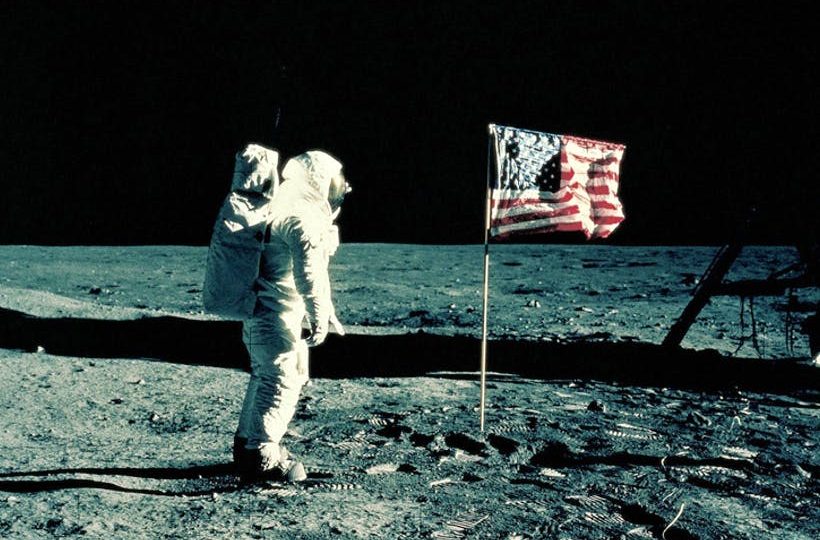
Moon Landing Anniversary Playlist: Space Music/Space Rock (1967 – 1974)
In 1966, Luna 9 and Luna 10 (Soviet Union spacecraft) were the first human made satellites to land on and orbit Earth’s moon. In December 1968 and May 1969, Apollo 8 and Apollo 10 (American spacecraft) were the first missions with astronauts to orbit Earth’s moon.
On July 20, 1969, Apollo 11 landed. Neil Armstrong and Buzz Aldrin were the first astronauts to walk on Earth’s moon. From 1969 – 1972, the Saturn V rocket continued to send additional American astronauts to Earth’s moon. On December 7-19, 1972, the last manned mission to Earth’s moon occurred. Harrison Schmitt, from New Mexico, is the last person that walked on Earth’s moon.
During this exciting era of exploration, there were equally exciting changes in music. Pioneered by the psychedelia of Pink Floyd and the kosmische musik of Tangerine Dream and later followed by bands such as Hawkwind and Gong, space music/space rock entered the headphones and turntables of listeners all around planet Earth. Space music/space rock reached its zenith in the early 1970s at the same time that missions to Earth’s moon multiplied and then ended.
“Astronomy Domine” (Pink Floyd)
Beginning with the band’s manager Peter Jenner reciting information about the solar system, Syd Barrett’s echoing guitar, and Richard Wright’s Farfisa organ emitting interstellar signals, “Astronomy Domine” could be considered the first space rock song. Syd Barrett name drops the planets Jupiter, Saturn, Neptune and his line “stars can frighten.” This track was different than the rest of the counterculture in 1967. While most psychedelia in the summer of love was about connecting to the earth, Syd Barrett’s acid-inspired lyrics sent hippies’ minds into outer space.
“Moonhead” (Pink Floyd)
Pink Floyd’s new lineup with David Gilmour on guitar (and Roger Waters at the controls as commander) spent less time writing lyrics and more time stretching out into instrumental improvisations. On the night that the Apollo 11 moon mission landed, the band recorded an instrumental live in the BBC studios. The track has a dark, ominous atmosphere: Roger Waters’ bass, Richard Wright’s floating Farfisa organ, and a vibraphone making the first human steps onto the lunar surface sound more mysterious.
“Higher and Higher” (The Moody Blues)
The progressive rock band The Moody Blues were also inspired by the Apollo 11 moon mission. “Higher and Higher”, the opening track of their 1969 album To Our Children’s Children’s Children, ignites with a rocket launch and a choir of voices ascending. Mellotron player Mike Pinder speaks the lyrics about humankind’s heroic and triumphant travel beyond Earth to the moon while energetic music climbs skyward.
“Sunrise in the Third System” (Tangerine Dream)
Alpha Centauri contains a dedication: “…to all people who feel obliged to space.” Edgar Froese was fascinated by space and influenced by Pink Floyd. However, he traveled much further than Floyd with himself on bass, guitar, and organ and his group of musicians (Christopher Franke on drums, percussion, zither, piano, VCS3 synthesizer; Steve Schroyder on organ, echo machines, iron stick; Udo Dennebourg on flute) when they recorded Alpha Centauri in 1971. This was the first instrumental record with every track composed completely about space. It was also innovative because it was not rock. It was electronic music designed to expand human consciousness beyond not only Earth, but beyond our solar system to asteroids (“Fly and Collision of Comas Sola”) and the nearest star system (“Alpha Centauri”). The opening track, “Sunrise in the Third System”, is certainly celestial–a church organ and Edgar Froese’s wailing, weird guitar.
“Ultima Thule” (Tangerine Dream)
Also in 1971, Tangerine Dream released a single “Ultima Thule” that was unlike any of their other tracks they would release in the future. This was heavy space rock. The only comparison is Hawkwind. In only 3 minutes, Edgar Froese’s hurtling, jagged guitar, Christopher Franke’s crashing drums, and Mellotron and organ set the scene. Apocalyptic.
“Master of the Universe” (Hawkwind)
The centerpiece of Hawkwind’s 1971 LP In Search of Space, this is actually the only track on the record specifically about space. Dave Anderson’s bassline is the engine powering this spaceship as Dave Brock on guitar and vocals, Nik Turner on altered saxophone, Del Dettmar on synthesizer, Dik Mik on audio generator, and Terry Ollis on drums pummel through a headbanging track that is space rock for Black Sabbath fans.
“Fohat Digs Holes in Space” (Gong)
Where Hawkwind made space rock for metalheads, Gong made space rock for jazz fusion freaks. This 1971 track opens with Didier Malherbe’s saxophone. The track is driven by the rhythms of Christian Tritsch’s head-nodding bassline and Pip Pyle’s percussion. Daevid Allen’s glissando guitar glides and Gilli Smyth’s orgasmic, sexy, wordless voice echoes. The first three minutes of the track are the spaciest. After the 3:30 point, Didier Malherbe’s saxophone reenters, followed by Daevid Allen’s wacky, zany lyrics and singing.
“Burn Out My Eyes” (Nektar)
While Tangerine Dream’s Alpha Centauri in 1971 was the first record of electronic instrumental music composed completely about space, Nektar’s Journey to the Centre of the Eye (also recorded in 1971) was the first space rock concept album with lyrics about an astronaut en route to Saturn who experiences an eye-opening journey with extraterrestrials. The album’s climax concerns the destruction of the planet Earth. “Burn Out My Eyes”, the longest track on the record, contains despairing and disillusioned lyrics and vocals by Roye Albrighton and mournful Mellotron/organ by Allan Freeman and Derek Moore.
“Space is Deep” (Hawkwind)
One of the spaciest Hawkwind tracks, recorded in 1972, the same year that astronauts embarked on the last mission to Earth’s moon. At 3:30, the band’s new, more muscular rhythm section of Lemmy Kilmister on bass and Simon King on drums blast this track off into overdrive.
“The Space Between” (Brainticket)
Brainticket’s 1973 Celestial Ocean is a bizarre concept album about Egyptian kings on their voyage to an astral afterlife. “The Space Between” is the mission statement of the record. Barney Palm’s tribal percussion and a French male voice speaks. Joel Vandroogenbroeck’s surreal synths swell as Carole Muriel recites philosophical passages:
“Across interior and exterior space
We are being increasingly conditioned by our surroundings
By realizing and perceiving between the just and unjust
You are offered a multitude of new dimensions
Space represents a room, a country, music, spirit, life, death, planets, galaxies, the worlds
We are passing between the relationship of darkness to light”
“The Isle of Everywhere” (Gong)
The spaciest track from Gong’s spaciest record You. Gilli Smyth’s and Miquette Giraudy’s orgasmic, sexy voices echo as Gong’s best band (Steve Hillage on guitar, Tim Blake on EMS synthesizers and Moog, Didier Malherbe on saxophone) are led by Gong’s best rhythm section. Pierre Moerlen’s fluid, loose percussion perfectly complements Mike Howlett’s absolutely addictive, hypnotic, seductive bass groove that keeps your head nodding for 10 minutes.
“Galactic Joke” (The Cosmic Jokers)
The most epic and quintessential space rock record. Rolf Ulrich-Kaiser secretly recorded LSD-fueled jam sessions in 1973 by guitar genius Manuel Gottsching (of Ash Ra Tempel), keyboardist Klaus Schulze, Dieter Dierks on bass, drummer Harald Grosskopf, and Jurgen Dollase. The Cosmic Jokers’ self-titled debut (released in 1974) is their greatest record: “Galactic Joke” is a 22-minute hallucinogenic, mind-blowing head trip.
by Mark Lager
